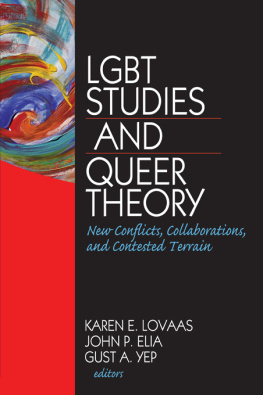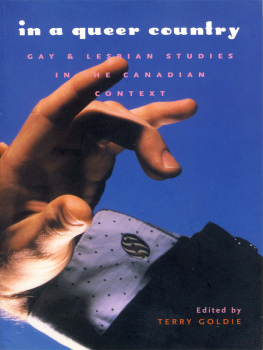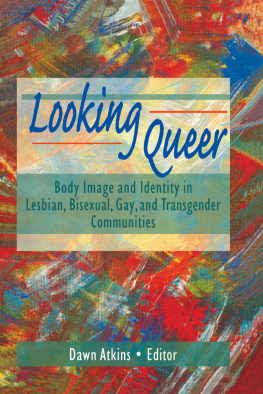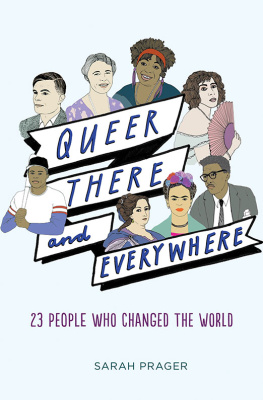Thank you for buying this ebook, published by NYU Press.
Sign up for our e-newsletters to receive information about forthcoming books, special discounts, and more!
Sign Up!
About NYU Press
A publisher of original scholarship since its founding in 1916, New York University Press Produces more than 100 new books each year, with a backlist of 3,000 titles in print. Working across the humanities and social sciences, NYU Press has award-winning lists in sociology, law, cultural and American studies, religion, American history, anthropology, politics, criminology, media and communication, literary studies, and psychology.
The Queer Renaissance
The Queer Renaissance
Contemporary American Literature and the Reinvention of Lesbian and Gay Identities
Robert McRuer

NEW YORK UNIVERSITY PRESS
New York and London
1997 by New York University
All rights reserved
Library of Congress Cataloging-in-Publication Data
McRuer, Robert, 1966
The queer renaissance : contemporary American literature and the
reinvention of lesbian and gay identities / Robert McRuer
p. cm.
Includes bibliographical references and index.
ISBN 08147-55542 (clothbound : alk. paper).ISBN
08147-55550 (paperbound : alk. paper)
1. Gays writings, AmericanHistory and criticism.
2. Homosexuality and literatureUnited StatesHistory20th
century. 3. Literature and societyUnited States20th century
History and criticism. 4. American literature20th century
History and criticism. 5. United StatesCivilization19706. Gender identity
in literature. 7. Lesbians in literature.
8. Gay men in literature. I. Title.
PS153.G38M381997
810.9920664dc21 9651220
CIP
New York University Press books are printed on
acid-free paper, and their binding materials are chosen
for strength and durability.
Manufactured in the United States of America
10 9 8 7 6 5 4 3 2 1
Contents
Introduction
Reading the Queer Renaissance
Chapter One
Boys Own Stories and New Spellings of My Name: Coming Out and Other Myths of Queer Positionality
Chapter Two
Queer Locations/Queer Transformations
Chapter Three
Unlimited Access? Queer Theory in the Borderlands
Chapter Four
Queer Identities in a Crisis
Epilogue
Post-Queer?
Preface
Every year, countless Americans from the forty-eight contiguous states flock to Hawaii, making tourism that states number one industry Travel agents, hotels, and airlines entice tourists by shaping the Aloha State into the land of beauty, romance, and imagination. A recent Vacations by Sheraton brochure, for instance, announces, Hawaii is as much a place of mind as it is a place on the map. A peaceful paradise where golden sunshine warms the spirit along with the body Where worry drifts away on azure waves. MTI Vacations adds, Hawaii is a honeymoon paradise! Youll be inspired by the breathtaking scenery and swept up in the romance of the islands. The industry supports these claims with visual evidence, scattering pictures of men and women in luxurious settings through every brochure: men and women standing beside waterfalls or pools, walking along the beach, or watching the tropical sunset.
Gay men and lesbians, however, have disrupted the fantasy of Hawaii as a romantic (heterosexual) paradise. In 1990, three same-sex couples filed a lawsuit claiming the state violated their civil rights by refusing to grant them marriage licenses. The Hawaii Supreme Court agreed and ordered a lower court to review the couples complaints. Since states have a long history of recognizing marriages legally performed in other states, the events in Hawaii provoked a flurry of legislative activity elsewhere. By the mid-1990s, legislators across the country had introduced bills that would ensure that their states would not have to recognize same-sex marriages performed in Hawaii. Congress even introduced the Defense of Marriage Act (DOMA), and members of both major political parties lined up behind it to show their support for the idea that marriage should be defined only as the union between one man and one woman. DOMA was passed and signed into law by President Bill Clinton in September 1996.
In this context, the already suspect metaphor of the mainland collapses under the weight of the crisis. Hawaii indeed becomes the mainland here, given its ability to drive the legislative agenda of the U.S. Congress and of many other states in the Union. The legislators panic, and that of their constituents, endows Hawaii with a threatening subjectivity that belies characteristic understandings of it as an island paradise passively awaiting heterosexual travelers. No longer simply a beautiful and distant place to escape to, Hawaiibecause it broaches the taboo subject of same-sex marriagebecomes a subject to escape from.
Nonetheless, to many gay men and lesbians (and indeed, to the litigating couples themselves), gay and lesbian marriage hardly constitutes a threat to civilization as we know it. On the contrary: proponents of lesbian and gay marriage openly admit that they dont want to threaten heterosexual marriage; instead, they want to uphold marriage by extending it to lesbians and gay men. Other gay men and lesbians see the issue somewhat differently. While not denying that lesbians and gay men should have equal access to the political and economic benefits marriage bestows on couples in American culture, they argue that the gay and lesbian marriage movement seeks admittance to an institution that gay liberationists have sharply and consistently critiqued.
The debate over marriage rights in Hawaii might actually extend those critiques, since it again makes visible the crises that circulate around marriage and the family The legislative panic in particular exposes the ways in which the idea of the family is grounded in a fear of contiguous states: that is, a fear of queer states and eroticisms that are supposed to be safely distant, marginal, and exotic but are, in actuality, always internal to the family, the community, the nation. The debate about marriage rights in Hawaii reveals that those queer states (indeed, like Hawaii) are not naturally distant, marginal, and exotic; rather, they are distanced, marginalized, and exoticized through the heteronormative processes that construct the family, the mainland, and civilization as we know it. It is crucial that queer activists and theorists continue to draw attention to those heteronormative processes, especially since the lesbian and gay marriage movement in fact repeats them; many advocates for same-sex marriage distance queer identities and communities that dont fit their new and improved model of family.
The Queer Renaissance: Contemporary American Literature and the Reinvention of Lesbian and Gay Identities examines how queer writers of the past fifteen years have shaped alternative relationships, communities, and identities. The 1980s and 1990s have seen an unprecedented wave of cultural activity by openly queer poets, playwrights, and novelists. The Queer Renaissance not only highlights that phenomenon but also considers how it works in tandem with a renaissance of radical queer political analysis that reinvents lesbian and gay identities and alliances in order to challenge dominant constructions of sex, sexuality, gender, class, and race.
Next page







